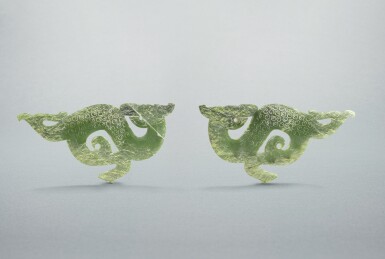Chinese Jades from the Xianquxuan Collection
Chinese Jades from the Xianquxuan Collection

A pair of celadon jade 'S-dragon' pendants, Eastern Zhou dynasty, Warring States period | 東周戰國 青玉龍形珮一對
Lot Closed
December 5, 03:29 AM GMT
Estimate
1,000,000 - 1,500,000 HKD
Lot Details
Description
A pair of celadon jade 'S-dragon' pendants
Eastern Zhou dynasty, Warring States period
東周戰國 青玉龍形珮一對
l. 18.5 cm
Collection of Hayashibara Museum of Art, Japan.
日本林原美術館收藏
Honouring Tradition and Heritage: Min Chiu Society at Sixty, Hong Kong Museum of Art, Hong Kong, 2021, cat. no. 280.
《聚道傳承 : 敏求精舍六十周年》,香港藝術館,香港,2021年,編號280
Beautifully curved into an S-shape, matching pendants of high quality such as the present lot are rare and would have been reserved for those of remarkably high status and rank. Dragon-shaped pendants of this form with ‘S’-shaped bodies appeared in the Spring and Autumn period, gained widespread popularity during the Warring States period, and gradually changed to a more fluid cloud-shaped form in the Han dynasty. Compare a closely related pair of green jade ‘S-dragon’ pendants, excavated from a late Warring States period tomb in Shaanxi province, illustrated in Liu Yunhui, Shaanxi chutu dongzhou yuqi [Eastern Zhou Jade Unearthed in Shaanxi], Beijing, 2006, pp. 212 and 215.
It is believed that the S-shaped jade dragon evolved from the tiger-shaped pendant, as evidenced an S-shaped dragon jade pendant excavated from the Warring States period tomb of the King of Zhongshan in Hebei province, with three ink characters “ta yu hu” (carved jade tiger) on its body, leading to assumption that the S-shaped jade dragon and jade tiger pendants during the Warring States period was not clearly distinguished at the time. For further discussion, see Jessica Rawson, Chinese Jade from the Neolithic to the Qing, London, 1995, pp. 260-261. See earlier examples of a S-shaped dragon pendant, late Shang dynasty, excavated from the tomb of Fu Hao, currently in the collection of the Institute of Archaeology, Chinese Academy of Social Sciences, illustrated in Queen, mother and general: 40th Anniversary of Excavating the Shang Tom of Fu Hao: Jade article, Beijing, 2016, p.8. See also two earlier and related jade dragon pendants, Western Zhou dynasty, excavated from the tomb of the Guo State, Henan province, illustrated in Yang Boda, zhongguo yuqi quanji, vol.2, Shijiazhuang, 2005, no.249; and another excavated in Shaanxi province, illustrated in zhongguo chutu yuiqi quanji, Beijing, 2005, vol. 13, p.51.
Compare also a closely related dragon pendant, late Spring and Autumn period, with a similar design of incised scrolls on both sides and a similar choice of jade stone, see ibid., vol.3, p.182; see another similar pair of jade dragon pendants, Warring States period, excavated in Jiangling County, Hubei province, illustrated in Yang Boda, ibid., pls. 260-266. See also four examples excavated in Huaiyang county, Henan, published in ibid., pls. 274-278.
For undecorated jade dragon pendants of similar S-shaped form, see Louisa G. Fitzgerald Huber, Ancient Chinese Jades from the Grenville L. Winthrop Collection in the Fogg Art Museum, Harvard University, Cambridge, 1975, pl. 429.Also compare another jade S-shaped dragon pendant from the Chinhuatang Collection, which was sold at Christie’s Hong Kong, 3rd December 2021, lot 2713.
青玉質,二龍同料對剖,猶見開料痕跡,龍身呈S形,正中一穿,回首,獨角,尾部分叉,陰刻榖紋龍鱗,細琢陰線勾勒口鼻耳目等細部,線條婉轉,玉質翠瑩溫潤。
本對龍形珮身形彎折呈S形,此形狀玉雕龍形珮春秋始見,戰國流行,漢代式微,取而代之是更為流暢婉轉如流雲般的身形,而春秋戰國時期之S龍,曲折有度,較之漢代龍形更為剛健有力。陝西省1987年戰國晚期秦國墓出土一對青玉龍形玉珮與本件十分相似,與同墓出土數件玉器合為組珮,可知此類S龍玉珮之佩戴方式,見劉雲輝編,《陝西出土東周玉器》,北京,2006年,頁212及215。有學者認為S形玉龍是由虎形珮演變而來,因河北戰國中山王墓出土一件S形龍玉珮,體形與本件亦頗類似,其身有墨書「它(砣)玉虎」三字,推測戰國時期S形玉龍玉虎珮其實涇渭並不分明,相關討論見Jessica Rawson著,《Chinese Jade from the Neolithic to the Qing》,倫敦,1995,頁260至261。此論可存一參,然早至商代已有類似S形之龍形玉珮,其勾線方法可謂一脈相承,參考一件商代晚期龍形玉珮,安陽婦好墓出土,中國社會科學院考古研究所藏,見《王后母親女將—紀念殷墟婦好墓考古發掘四十周年玉器篇》,北京,2016年,頁8。西周之龍形珮亦有類似於此類S形發展趨勢,如河南西周虢國墓出土之兩件西周龍形珮,見楊伯達編,《中國玉器全集》,石家莊,2005年,卷2,圖版249;以及陝西出土之西周龍形玉珮,見《中國出土玉器全集》,北京,2005年,卷13, 頁51。
春秋以來S龍玉珮漸多,主要特征為身體曲如S形,口唇、龍角皆削平,爪如魚鰭,尾兩叉,龍鱗多作榖紋,有平面與淺浮雕兩種。本件屬於平面陰紋之屬,榖紋以斜刀砣出,明暗對比鮮明,可比較太原金勝村趙卿墓出土之春秋晚期龍形玉珮,玉質、風格與本件頗類,見前書,卷3,頁182;湖北省江陵縣出土一對戰國晚期龍形玉珮以及澧縣出土一隻戰國晚期龍形玉珮,亦與之似,見楊伯達前書,圖版260及266 ;以及河南淮陽縣一墓出土之四例,見前書,圖版274至278。
此類陰紋S形龍珮亦有完全光素者,可參考美國哈佛大學博物館藏一件戰國龍形珮,光素無紋,或為半成品,著錄於羅越及Louisa G. Fitzgerald Huber著,《Ancient Chinese Jades from the Grenville L. Winthrop Collection in the Fogg Art Museum, Harvard University》,劍橋,1975年,圖版429。台北金華堂舊藏一件戰國晚期龍形玉珮,亦屬S龍一類,惟見陰勾細線,無榖紋,屬同類之變體,2021年12月3日見售於香港佳士得,編號2713。
